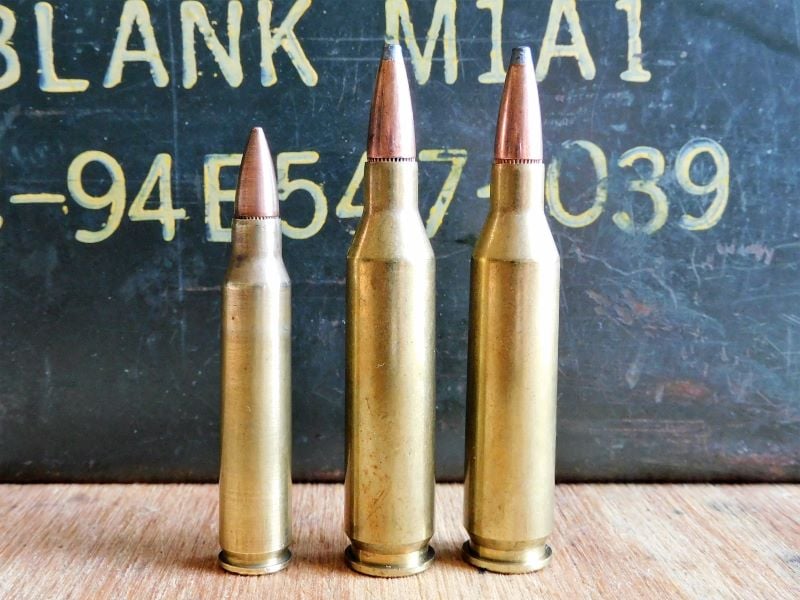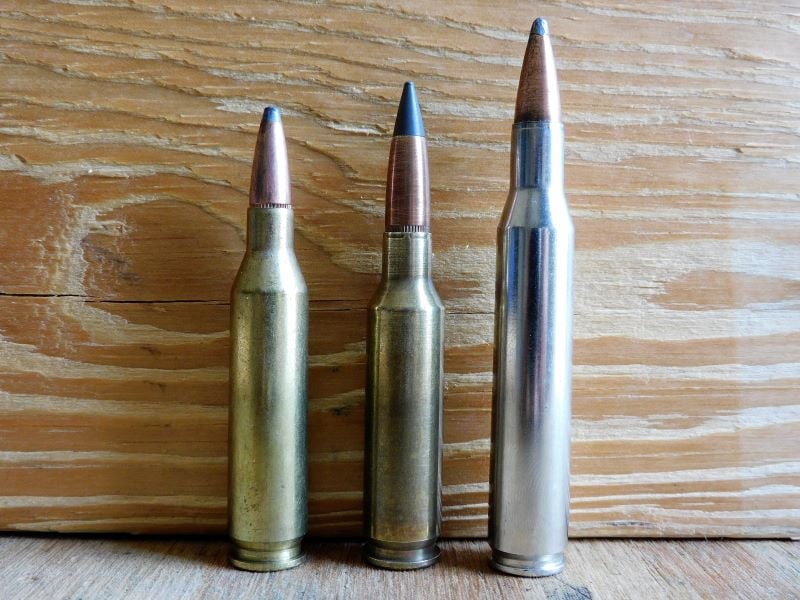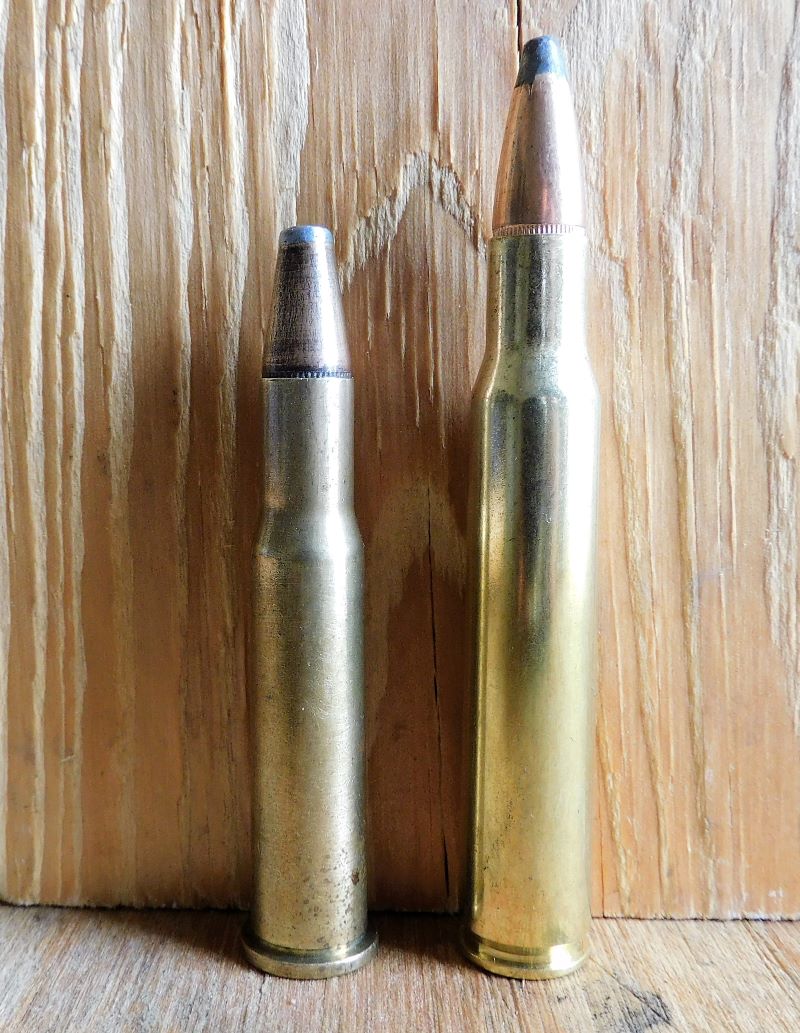Summer heat is over for the year, and that means fall has welcomed us with dropping temperatures, falling leaves, and deer season. If you are looking to get into deer hunting or even upgrade your equipment for the coming season, there is still some time to grab a rifle, some ammo, and hit the range for a good sight-in. Although choosing a quality rifle is paramount for the mission, we do have to talk about caliber.
Maybe you want to try a new caliber that might extend your range or reduce felt recoil. Maybe you are looking to start and don’t know the difference between the 6.5 Creedmoor and the .243 Winchester, or what the dashes mean between .30-30 or .30-06. There are more good rifle rounds out there that enjoy a good reputation on deer, but which is better for you? Here are six well-reputed deer cartridges and how they stack up against one another.

The .243 Winchester
I started deer hunting as a small kid in the 1990s. This was before the low-recoiling .223 Remington and the AR-15 rifle became particularly popular for whitetail. If you were a kid or a particularly recoil-sensitive shooter, the .243 Winchester and .30-30 Winchester were, and are, popular choices. While I gravitated to the .30-30, the .243 is a ballistic delight that punches above its weight.

The .243 was introduced by Winchester in 1955 with the Model 70 bolt action rifle. This bottlenecked round is the then-new .308 Winchester round’s case necked down to .24 or 6mm caliber. The use of a smaller caliber bullet with this case allowed for higher velocity and less recoil over the heavier .30 caliber round.
The .243 Winchester round exists in two different worlds: varmint and deer hunting. The .243 Winchester can be had with bullet weights lower than 60 grains, which can be pushed at close to 4000 feet per second. 85-100 grain soft-point bullets in the neighborhood of 3000 feet per second are par for the course for whitetail hunting. The heavier-grain bullet offerings have a high ballistic coefficient for excellent wind resistance and a flat trajectory compared to the .308. On the shoulder, the .243 has a soft push similar to the .30-30. But don’t let the lack of bite on the shooter’s end fool you. Although the .243 is, on paper, the least powerful of the rounds on this list, it can hit out to 400 yards with authority and negligible bullet drop.
The 6.5 Creedmoor
Since the very beginning of rifle cartridges, we have sought more power delivered at longer ranges with less bullet drop. When the 50-70 Gov’t round proved too elliptical for long-distance buffalo hunting, along came the 50-90 and the 50-140. The envelope always has to be pushed. 6.5mm rifles are well known for their long, efficient bullet designs that buck the wind but are sufficiently small bore enough to have lower recoil compared to .30 caliber rounds. The 6.5 Creedmoor is just one of the latest 6.5mm rifle rounds, but it is among the first to be developed with long-range competition shooting in mind.
The 6.5 Creedmoor was developed in 2007 by taking the obscure .30 TC case and necking it down to 6.5mm. This rifle round has a shorter case that allows it to work with intermediate action rifles with a short bolt through, unlike older military rounds like the 6.5x55mm Swede.

The 6.5 Creed has a cultish fanbase, including those who do not compete at long range. As it turns out, it is a great longer-range deer round as well. It shoots standard 120-140 grain 6.5mm projectiles between 2700 and 3050 feet per second, giving it a slight ballistic edge over other 6.5 rounds. Like the .243, the 6.5 has a flatter trajectory and better wind resistance over larger rounds. The 6.5 does have more recoil than the .243, but its heavier bullet weights allow it to compete more favorably at distances beyond 400 yards.
The .270 Winchester
After World War I, the .30-06 Springfield cartridge, then America’s military rifle round of choice, became increasingly popular with the shooting public. As the same song repeats, more efficient rounds were wanted. In 1925, Winchester took the existing .30-06 cartridge and necked it down to .277 caliber. It was debuted in the Winchester Model 54 rifle, which had a bore diameter of .270 inch. The Model 54 was short-lived but the new .270 Winchester would stand the test of time. After World War II, the influx of easily rechamberable .30-06 military rifles spurred the .270’s popularity. The writings of hunters like Col. Townsend Wheelen and Jack O’Connor cemented this flatter shooting round as an excellent deer and elk round.
Like the .243 and 6.5 Creed, the .270 is predominantly a bolt action rifle cartridge. It is a full-length rifle cartridge, just like the .30-06, and requires a long action through to cycle. The .270 also has enough recoil that might give a new shooter bad habits, but not as severe as the .30-06 it is based upon. The .270 makes up for this with ballistics.

The standard 130-grain soft-point deer load available from manufacturers like Federal and Winchester comes out at 3,000 feet per second. It has more authority than the smaller .243 and is flatter shooting than larger rounds, although there is some power overlap between it and the 6.5 Creedmoor. Heavier 150-grain blunt-nosed bullets are readily available for the .270, but these have more drop and more recoil than 6.5 Creed 140-grain or .270 130-grain loads. Most .270 rifles use a 1 in 10 twist, which limits their ability to accurately shoot heavier bullets to achieve ballistic parity with the 6.5.
.308 Winchester
In the late 1940s, the US Army was looking for a shorter-length rifle round to replace the venerable .30-06. Although the Aught Six had served the military well through both World Wars, it was longer than necessary for a full-powered battle cartridge to be used in modern autoloading rifles. A shorter case with more modern powders could do the job.
The resulting .308 Winchester was introduced in 1952, two years before the Army adopted the round as the 7.62×51 NATO. The round quickly became a favorite for law enforcement and civilian shooters, particularly in rifles like the Winchester Model 70 and Remington Model 700 bolt action rifles. Today the .308 Winchester is available as an offering from every major rifle manufacturer and is largely a bolt action round, although autoloading rifles like the AR-10 have grown in popularity.
The .308, as it debuted, uses a 150-grain spire-point bullet traveling at about 2,800 feet per second. This load is by far the most common on the market, but common bullet weights range from 125-168 grain. The shorter 51mm case allows it to be chambered in short action rifles compared to the longer 63mm length of .30-06. But that shorter case does limit powder capacity and bullet weights, where the .30-06 retains an advantage. This difference means the .308 will have somewhat less recoil than the .30-06 or its .270 cousin, but the .308 also has somewhat less power potential. In some parts of the country, this disadvantage is negligible but at extreme ranges in field conditions, the .308 is less flexible. That is where those other rounds come in. Dissatisfaction with rounds like the .308 in long-range competition also spawned rival cartridges, like the lauded 6.5 Creedmoor. Even so, the .308 hits with more authority than that round, and factory hunting loads place the .308 Winchester as a more recoil-friendly version of the .30-06 with slightly shorter legs.

.30-30 Winchester
The .30-30 Winchester or .30 WCF debuted with the Winchester 1894 lever action rifle in 1895. It is called the 30-30 based on the old black powder cartridge nomenclature of the time. A 45-70 would be a .45 caliber bullet over a nominal 70 grains of powder. The 30-30 is a .30 caliber bullet over 30 grains of powder. But this is not a black powder round. It is the first smokeless powder sporting round to debut on the American market and the Grand Daddy of all the rounds on this list! Although the round is lightly powered compared to what would come later, the .30-30 refuses to fade away, and with good reason.
In terms of size, the .30-30 is the same length as the .308 Winchester round, but it uses a rimmed case and generally uses flat-nosed soft-point bullets so that the round will work in lever action rifles. Although single-shot and bolt action rifles have been offered in .30-30, this round is synonymous with levers.

Compared to other cartridges, the .30-30 is most similar to the .243. It pushes a 150-170 grain bullet at about 2,000-2,200 feet per second, making it sedate by modern rifle standards. This lower velocity, combined with its featured flat-point bullets, limits its power and range compared to other rounds. However, those same detriments can be a benefit. The .30-30 boasts very low recoil and the larger caliber and bullet gives more comfort to those of us who might feel the .243 looks too small to do the job. The flat-point bullet also does a remarkable job at imparting its energy on target, leaving a heavier blood trail on game than its outward ballistics would suggest.
Growing up, I learned the .30-30 was worthless at 100 yards only to find it to be perfectly capable at 250. Beyond 300 yards, the .30-30 round begins to drop more noticeably on target. In a sense, the .30-30 is a short-range round only when comparing it to other rounds that can go so much further. But within its limitations, it has its benefits.
.30-06 Springfield
The .30-06, like the 30-30, was built from the ground up as a smokeless powder high-velocity rifle cartridge. The .30-06 Springfield designation reflects the round’s military origins: a .30 caliber round adopted in 1906 and developed by Springfield Armory (the old arsenal, not the company).
.30-06 is a modern rimless round that uses a pointed spitzer bullet rather than a flat point bullet as seen on earlier cartridges like the .30-30 Winchester. It is a round designed for the M1903 Springfield bolt action rifle and could hit a target with authority out to 1000 yards and beyond. It had somewhat more power than existing 6.5mm and 8mm military cartridges of the time and it was not long before American manufacturers began to turn out civilian arms for the Aught Six.
The Aught Six became more popular for hunting as bolt action military rifles were surplused after the Second World War. But iconic civilian rifles like the Winchester 1895 and Model 70 were just a few of many hunting rifles chambered for the round. It even spawned a few successor rounds like the .270 Winchester.
The .30-06 remains one of the most popular big game rounds in North America. The Aught Six has an impressive portfolio of bullet weights loaded for it, ranging from 110-220 grains. For American whitetail, soft-point 150-180 grain loads are ideal, while heavier loads lend themselves well to elk and bear.
The .270 Winchester is a popular substitute for the ’06, as its lighter bullet has a somewhat flatter trajectory and fosters a bit less recoil. But the ’06 has bullet weight flexibility the .270 simply doesn’t and typical whitetail loads with the former are traveling at roughly the same velocity as the latter’s lighter bullet. That translates to more energy on target further downrange, although both rounds are more than capable of putting down deer past 400 yards. The greater mass at the same velocity does translate into more felt recoil. The .30-06 marks the power and recoil level that many shooters, including myself, will find to be at the edge of comfort. Recoil becomes more prohibitive with slightly more powerful rounds like the 7mm Remington Magnum and the .300 Winchester Magnum.
The .30-06’s mass popularity, just like the .30-30 and .308 Winchester, also translates to less expensive and plentiful ammunition. Ammunition prices rounds like the .243, .270, and 6.5 Creedmoor tend to be higher.
The Bottom Line
The .243 Winchester, 6.5 Creedmoor, .270 Winchester, .30-30 Winchester, .308 Winchester, and .30-06 are not the only viable deer rounds on the market today, but they hold a virtual monopoly in terms of ammo on the shelf and rifles in racks. Depending on your experience as a shooter, your physical limitations, the ranges at which you expect, and whether or not you are stylish, there is no one cartridge, there is just the cartridge that is best for you.
The kid shooter and experienced hunter who splits her time between coyote and whitetail might be best served with the excellent .243 Winchester. The brush hunter can do with the short legs and hearty punch of the old .30-30, while plains hunters will appreciate the extra powder of the .270, .308, or .30-06. And those who like 6.5 will use a 6.5. In the end, all are right answers, but no round will save you from getting ribbed when you get back to camp.

